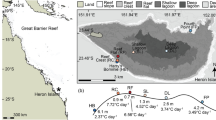Abstract
The growth relations of the kelpLaminaria solidungula were examined in the summers of 1984 and from 1986 to 1989 in relation to continuous year-round measurements of photosynthetically active radiation (PAR) at several sites in the Stefansson Sound Boulder Patch, Alaskan Beaufort Sea. PAR showed large seasonal differences, ranging from a maximum of 5µmol m−2 s−1 during the ice-covered months to 200µmol m−2 s−1 during the open-water season. In most years, the light received during the 9 mo ice-covered period represented < 10% of the total PAR reaching the plants. Annual variations in PAR ranged from 45 to over 89 mol m−2 yr−1 over the 4 yr period among sites. In 1988, annual quantum budgets forL. solidungula varied from 45 to 50 mol m−2 yr−1, close to that reported in the previous year, and near the annual minimum light requirement reported in other studies for the lower limit ofLaminaria spp. However, the duration of time that the plants were exposed to saturating levels of PAR in 1988 was considerably less than in other years. This was correlated with significant reductions in thallus tissue-density and carbon content during the summer open-water period in 1988. Percentage of dry to wet weight (tissue density) dropped from about 16 to 10%; carbon content from 35 to 28%. The drop in both indices indicated that 1988 summer open-water (ice-free) PAR was insufficient for maintaining maximum photosynthetic carbon fixation. The decreased storage of carbohydrate reserves, which are used for tissue expansion during the dark ice-covered period, resulted in significantly reduced linear growth in all plants the following year (1989). These results provide evidence that in low-light environments, plant production is more a function of exposure to saturating levels of PAR than to the total amount of photons received over the course of a growing season. Under these conditions, under-ice photosynthetic production at very low light levels becomes increasingly important forL. solidungula if it is to meet the metabolic demands imposed by winter growth and respiration.
Similar content being viewed by others
Literature cited
Chapman, A. R. O., Lindley, J. E. (1980). Seasonal growth ofLaminaria solidungula in the Canadian High Arctic in relation to irradiance and dissolved nutrient concentrations. Mar. Biol. 57: 1–5
Dean, T. A. (1985). The temporal and spatial distribution of underwater quantum irradiation in a southern California kelp forest. Estuar., cstl Shelf Sci. 21: 835–844
Dennison, W. C., Alberte, R. S. (1985). Role of daily light period in the depth distribution ofZostera marina (eelgrass). Mar. Ecol. Prog. Ser. 25: 51–61
Dunton, K. H. (1984). An annual carbon budget for an arctic kelp community. In: Barnes, P. W., Schell, D. M., Reimnitz, E. (eds.) The Alaskan Beaufort Sea: ecosystems and environments. Academic Press, Orlando, p. 311–326
Dunton, K. H., Jodwalis, C. M. (1988). Photosynthetic performance ofLaminaria solidungula measured in situ in the Alaska High Arctic. Mar. Biol. 98: 277–285
Dunton, K. H., Reimnitz, E., Schonberg, S. (1982). An arctic kelp community in the Alaskan Beaufort Sea. Arctic 35: 465–484
Dunton, K. H., Schell, D. M. (1986). Seasonal carbon budget and growth ofLaminaria solidungula in the Alaskan High Arctic. Mar. Ecol. Prog. Ser. 31: 57–66
Hiscock, K. (1986). Aspects of the ecology of rocky sublittoral areas. In: Moore, P. G., Seed, R. (eds.) The ecology of rocky coasts. Columbia University Press, New York, p. 290–328
Kirk, J. T. O. (1983). Light and photosynthesis in aquatic ecosystems. Cambridge University Press, Cambridge
Kondratyev, K. Y. (1954). Radiant solar energy [In Russ.]. Leningrad. [cited after Kirk (1983)]
Lüning, K. (1981). Light. In: Lobban, C. S., Wynne, M. J. (eds.) The biology of seaweeds. University of California Press, Berkeley, p. 326–355
Lüning, K., Dring, M. J. (1979). Continuous underwater light measurement near Helgoland (North Sea) and its significance for characteristic light limits in the sublittoral region. Helgoländer wiss. Meeresunters. 32: 403–424
Reimnitz, E., Kempema, E. W. (1987). Field observations of slush ice generated during freeze-up in arctic coastal waters. Mar. Geol. 77: 219–231
SAS Institute Inc. (1985). SAS/STAT guide for personal computers. Version 6 ed. SAS Institute Inc., Cary, North Carolina
Sears, J. R., Cooper, R. A. (1978). Descriptive ecology of offshore, deep-water, benthic algae in the temperate Western North Atlantic Ocean. Mar. Biol. 44: 309–314
Vadas, R. L., Steneck, R. S. (1988). Zonation of deep water benthic algae in the Gulf of Maine. J. Phycol. 24: 338–346
Author information
Authors and Affiliations
Additional information
Communicated by J. M. Lawrence, Tampa
University of Texas Marine Science Institute Contribution No. 764
Rights and permissions
About this article
Cite this article
Dunton, K.H. Growth and production inLaminaria solidungula: relation to continuous underwater light levels in the Alaskan High Arctic. Mar. Biol. 106, 297–304 (1990). https://doi.org/10.1007/BF01314813
Accepted:
Issue Date:
DOI: https://doi.org/10.1007/BF01314813




